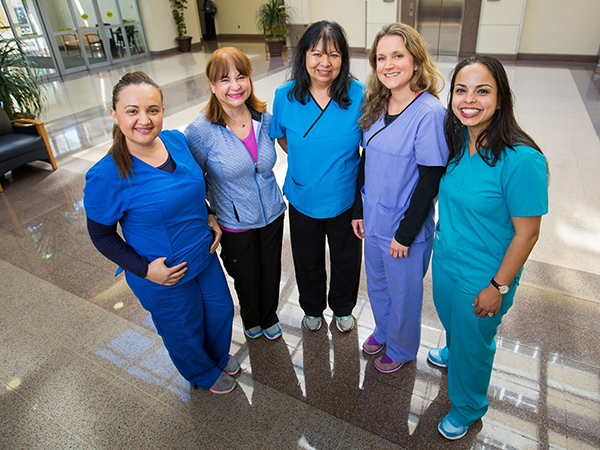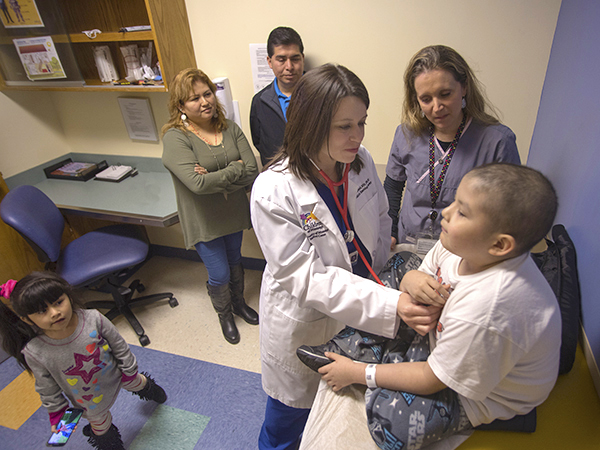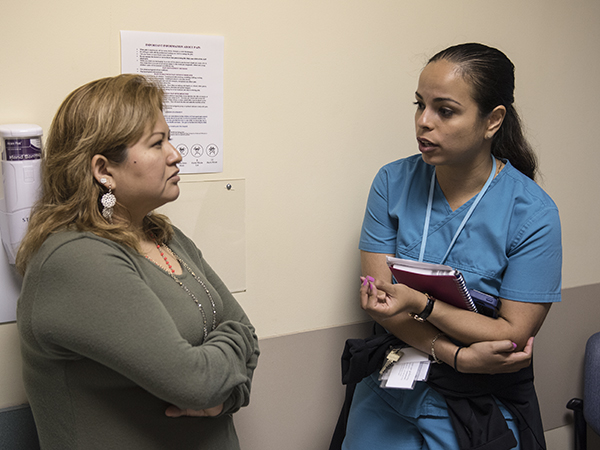Interpreter-patient relationship translates into trust

Published in News Stories on May 15, 2017
Unlike his Spanish-speaking parents, who came to America from Mexico, Angel Martinez, 7, is fluent in the language of their adopted country.
But when would it be OK to ask someone so young to tell his parents he has a blood-related cancer? When would it be OK to ask this first-grader to explain for them the complications of his illness, Philadelphia chromosome-positive acute lymphoblastic leukemia?
At UMMC, those questions are answered by a group of medical interpreters working out of the Office of Patient Experience: “Nunca. Jamas. Never.”
Among them are Leslye Bastos Ortega, manager of Language Services & Patient Advocacy; and Diva McCardle: two interpreters who have worked closely with Miguel and Nicolasa Martinez during their son Angel's visits to Batson Children's Hospital for treatment.
“I'm very thankful for all those who have helped us out during the tough visits,” said Nicolasa speaking through Ortega.
“Diva is always coming by to see if we need anything, even when the doctors don't call for her.”
At UMMC and its outpatient clinics, physicians and other health care providers may call Language Services whenever their patients need medical information converted into Spanish.

The Martinez family, from left, Hillary, Nicolasa and Miguel are attentive as Angel, right, is examined by nurse practitioner Tobi Breland; standing by is medical interpreter Nicole Marr.
Besides Ortega and McCardle, two other Spanish interpreters are available: Nicole Marr, who works mostly with adult patients and is one of only three Certified Medical Interpreters in the state; and Iris Dale, who serves UMMC clinics at the Jackson Medical Mall, interpreting for around five to 10 patients daily.
“I wanted to help people, to help children. That's why I'm here,” said Dale, a registered nurse who moved here from the U.S. territory of Puerto Rico in 2004. “And I'm also here because I married someone from Mississippi. But I love this. It's a nice job.”
Dianne Gilbert, the Medical Center's tribal liaison for the 10,000-member Mississippi Band of Choctaw Indians, is the go-to interpreter for patients more at home with their Native American language.
“I guess they feel better with me there,” said Gilbert, who also arranges transportation for patients who live on the Choctaw Indian Reservation in east central Mississippi.
Patients may also seek help from UMMC's interpreters over the phone. Counting such calls, on average, Marr and McCardle each have 150-250 patient encounters per month, many in the Emergency Department.
“When people are in stressful situations, they revert to their native tongue,” Marr said. “They feel more comfortable speaking it.”
UMMC's medical interpreters work Monday through Friday, 8 a.m. to 4:30 p.m., but there is a phone number Spanish speakers may call after-hours or on weekends to reach a contracted interpreting service. In fact, the Optimal Language Line, open 24 hours a day, offers interpreters for more than 200 different languages.
But, by far, the foreign language heard most often here is the one spoken by Angel's mom and dad, natives of Oaxaca now living in Forest.
On their visits to the Children's Cancer Clinic for Angel's chemotherapy, they also bring daughter Hillary, 4, who speaks English. She is there to “cheer up” Angel, as Nicolasa put it.
“She's just here for the toys,” said Angel, a typical brother.
In spite of Angel's and Hillary's proficiency in English, “we make sure to never use children to interpret for the parents,” Marr said. This avoids potential mistakes.
The Martinez family is part of what may sound like a relatively small share of Medical Center patients who are Hispanic (Spanish-speaking in origin) or Latino (of Latin American origin): 1.95 percent in 2016.

Martinez, left, listens to an explanation from Ortega during a visit to the Children's Cancer Clinic.
But, as UMMC recorded a total of 1,400,536 patients last year, this translates into more than 27,300 Hispanics or Latinos; more to the point: the Medical Center recorded 16,429 encounters with Spanish-speaking patients.
For McCardle, who works mostly with children, many of those appointments pop up in the fall and winter. “That's flu season, and children are in school,” she said
The numbers reflect encounters that are inpatient or outpatient, by phone - including the Language Line - or face-to-face in 2016; they cover doctor's appointments, scheduling needs, questions about consent forms and much more.
But the tally does not take into account requests for Mixtec (spoken in several Mexican states and in California) or for dialects indigenous to Guatemala, the Mexican state of Chiapas and others. “But those are available on the Language Line,” Ortega said.
While there is also a heavy demand for sign language - an average of 71 patient encounters per month, Ortega said - those requests are coordinated by a social worker who brings in interpreters from outside UMMC.
As for requests on the Language Line alone, Spanish was No. 1, with 8,214, followed by Arabic, 286, and Vietnamese, 207.
Obviously, the alpha and omega of medical interpretation at UMMC is the demand for Spanish; the alpha dates back no later than 2003, when Eloise Lopez-Lambert, a School of Nursing instructor, became overwhelmed by clinicians' petitions for her Spanish skills.
Eventually, this led Medical Center officials to record the number of patients whose primary language was Spanish - 500 per month at that time. And that resulted in the hiring of full-time interpreters.
Meeting such a patient need is an antidote to disparities in treatment - that is, differences in the quality of, and access to, health care by race, ethnicity or socioeconomic status: If a health care provider can't understand a patient's medical history, the wrong type of treatment looms large.
And when it comes to building patient trust, translating a phrase such as “I'm going to feel your stomach” cries out for exactitude.
Pleas for skilled interpreters seem destined to grow more urgent, here and nationwide. By 2021, about half of newly-insured patients in this country will be less likely to speak English, as reported in 2015 by a division of The Joint Commission.
In Mississippi, about 90,000 residents are Hispanic, a U.S. Census Bureau estimate; among the languages spoken statewide, Spanish is second only to English in frequency.
Confronted with this need, the medical interpreters boosted their ranks after designing a free, internal competency exam suited to a variety of providers and students. “We wanted to make it as comprehensive as we could,” Marr said. “Once a year, they can take a condensed, refresher test.”
More than 20 staffers and students have qualified to serve as their own interpreters, although they may still request one from Language Services. “There's always backup, if they need it,” Ortega said.
To further dampen demand, a video interpreting service is on the horizon. Able to provide up to 17 languages, it was piloted here last year at clinics, hospitals, ICUs, etc., and offers face-to-face, on-demand translations remotely for about $1.05 per minute, Ortega said.
For their part, though, Miguel and Nicolasa Martinez said they prefer the interpreters they already know, standing beside them and their son.
“They're excellent people,” Nicolasa said in Spanish, expressing a gratitude that knows no country.

For more information concerning UMMC Interpretive Services, contact Leslye Bastos Ortega, (601) 984-2027. For the Optimal Language Line, call 1-877-746-4674, or the Language Line Fast Service: (321) 441-7086.
Top Language Line Requests, 2016
- Spanish: 8,214 (this number is included in the 2016 total for all inpatient and outpatient Spanish requests: 16,429)
- Arabic: 286
- Vietnamese: 207
- Hindi and Mandarin: 80
- Punjabi (one of the most widely spoken Indo-Aryan languages): 61
- Korean: 35
- Gujarati (language native to the Indian state of Gujarat): 23
- Cantonese: 19
- French: 17
- Chuj (a Mayan language): 14
- Mam (a Mayan language): 7
- Telugu: (a language native to India): 5
- Akateko: (a Mayan language) and Bengali: 4
- Farsi (official language of Iran), Russian and Urdu (a language closely related to Hindi): 3
- Creole, German, Italian and Portuguese: 2
- Amharic (language spoken in Ethiopia), Burmese, Cambodian, Dinka (language spoken mainly in southern Sudan), Greek, Kanjobal (a Mayan language), Malayalam (a language spoken in India), Mixtec, Polish, Quiche (a Mayan language) and Tagalog (language widely spoken in the Philippines): 1


